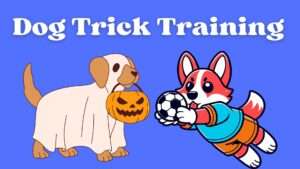Training your furry friend can be an immensely rewarding experience.
Not only does it strengthen the bond between you and your canine companion, but it also ensures a harmonious relationship based on clear communication and mutual respect.
One of the fundamental aspects of dog training is mastering basic commands.
These commands serve as the building blocks for further training and help establish essential behaviors that make living with your dog more enjoyable.
In this comprehensive guide, we’ll walk you through everything you need to know to effectively train your dog in ten basic commands.
Contents Overview
Preliminary Summary
Mastering basic commands is vital for effective communication and a well-behaved canine companion. In this guide, we’ve outlined ten essential commands every dog should learn.
From “sit” and “stay” to “come” and “heel,” these commands lay the foundation for obedience and safety.
Teaching your dog to “leave it” and “drop it” prevents unwanted behaviors, while commands like “off” and “wait” establish boundaries and impulse control.
Building focus with “watch me” enhances communication, fostering a strong bond between you and your furry friend.
With consistency, patience, and positive reinforcement, you can successfully train your dog in these essential commands, ensuring a harmonious relationship based on trust and mutual understanding.
Why Mastering Basic Commands Matters
Before diving into the specific commands, let’s understand why mastering them is crucial for both you and your dog:
- Communication: Basic commands provide a common language between you and your dog, facilitating effective communication.
- Safety: Commands like “come” and “stay” can be lifesaving in situations where your dog’s safety is at risk.
- Behavioral Management: Teaching basic commands helps manage and prevent unwanted behaviors, fostering a well-behaved pet.
- Bonding: Training sessions strengthen the bond between you and your dog, enhancing trust and mutual understanding.
The Ten Essential Commands
1- Sit
Teaching your dog to sit on command is one of the most fundamental exercises in obedience training. It promotes calmness and attentiveness while laying the groundwork for further commands.
Guide:
Start in a quiet, distraction-free area.
Hold a treat close to your dog’s nose, allowing them to smell it.
Slowly raise the treat above their head, leading their nose upwards.
As your dog follows the treat, their bottom will naturally lower into a sitting position.
Once they’re seated, say the command “sit” and immediately reward them with the treat and praise.
Repeat this process multiple times, gradually phasing out the treat until your dog responds reliably to the verbal command alone.
2- Stay
The “stay” command teaches your dog patience and self-control. It’s essential for situations where you need your dog to remain in place, whether it’s for safety reasons or during grooming sessions.
Guide
Begin with your dog in a sitting or standing position.
Hold your hand up, palm facing your dog, and say “stay” in a firm but calm voice.
Take a small step back while maintaining eye contact with your dog.
If they remain in place, return to them, praise them, and offer a treat.
Gradually increase the distance and duration of the “stay” command, always rewarding your dog for successful attempts.
3- Come
A reliable recall command is vital for your dog’s safety, allowing you to call them back to you in any situation. Consistent practice is key to ensuring a strong recall response.
Guide:
Start indoors or in a fenced area to prevent your dog from running off.
Get down to your dog’s level and use an enthusiastic tone to call their name followed by the command “come.”
As they approach you, encourage them with praise and rewards.
Practice the recall command regularly, gradually increasing the distance and distractions in the environment.
Down
Encourage relaxation and submission with the “down” command, teaching your dog to lie down on cue. This command is useful for calming excitable behavior and promoting relaxation.
Guide:
Begin with your dog in a sitting position.
Hold a treat in your hand and lower it to the ground in front of your dog’s nose.
As they follow the treat, guide them into a lying down position.
Once they’re down, say the command “down” and reward them.
Repeat the process, gradually phasing out the treat until your dog responds reliably to the verbal command alone.
Heel
Walking calmly beside you is a skill every dog should learn. The “heel” command teaches your dog to walk politely on a leash without pulling or straying.
Guide:
Start with your dog on a leash and standing on your left side.
Hold a treat in your left hand and keep it close to your dog’s nose to maintain their attention.
Begin walking, and whenever your dog starts to pull or stray, use the treat to guide them back into position.
Use the command “heel” when your dog is walking calmly beside you, rewarding them for good behavior.
Practice walking in various environments with distractions, reinforcing the heel command consistently.
Leave it
Dogs are naturally curious, but not everything they encounter is safe or appropriate. The “leave it” command teaches your dog to ignore or leave objects, food, or distractions on command, preventing potential hazards.
Guide:
Place a low-value item, such as a toy or treat, on the ground within your dog’s reach.
When they show interest in it, cover the item with your hand and say “leave it” in a firm tone.
Wait for them to lose interest and redirect their attention to you.
As soon as they look away from the item, praise and reward them with a higher-value treat.
Practice this command with different items and gradually increase the level of temptation.
Drop it
Resource guarding can be a concerning behavior in dogs. Teaching the “drop it” command helps prevent conflicts by encouraging your dog to release items from their mouth willingly.
Guide:
Begin by offering your dog a toy or object to hold in their mouth.
Hold a treat in front of their nose to grab their attention.
Say the command “drop it” in a calm but assertive tone.
As soon as they release the object, praise them and offer the treat as a reward.
Practice this command regularly during playtime to discourage resource guarding behavior.
Off
Jumping on people or furniture can be disruptive and even dangerous. The “off” command establishes boundaries and teaches your dog to keep all four paws on the ground.
Guide:
When your dog attempts to jump on you or furniture, calmly say “off” and turn away.
Ignore them until they have all four paws on the ground.
Once they’re down, praise them and offer attention or a treat as a reward.
Consistently reinforce the off command whenever your dog attempts to jump, gradually reducing the frequency of jumping behavior.
Wait
Impulse control is an essential skill for dogs. The “wait” command teaches your dog to pause or wait for permission before proceeding, whether it’s through a door or during mealtime.
Guide:
Start by asking your dog to sit or stand in a designated spot.
Use a hand signal or verbal cue such as “wait” while holding your palm out in a stop gesture.
Take a step back or move away slightly, keeping eye contact with your dog.
If they remain in place, return to them and offer praise and a treat.
Gradually increase the duration of the wait command, rewarding your dog for patience and self-control.
Watch me
Building focus and engagement is crucial, especially in distracting environments. The “watch me” command encourages your dog to make eye contact, fostering attentiveness and reinforcing your bond.
Guide:
Hold a treat in front of your face to attract your dog’s attention.
Say the command “watch me” and bring the treat close to your eyes.
When your dog makes eye contact, praise them and offer the treat as a reward.
Repeat this exercise, gradually increasing the duration of eye contact before giving the treat.
Practice the watch me command in various situations to reinforce focus and engagement.
Bottom Line
Welcoming a puppy into your home is an exciting journey filled with love and joy.
Unlock the secrets to harmonious companionship and joyful obedience with expert guidance in mastering puppy training.
Bottom Line
Welcoming a puppy into your home is an exciting journey filled with love and joy.
Unlock the secrets to harmonious companionship and joyful obedience with expert guidance in mastering puppy training.
































+ There are no comments
Add yours